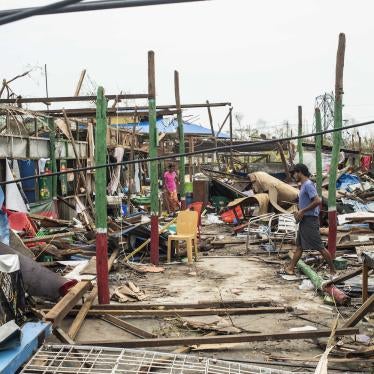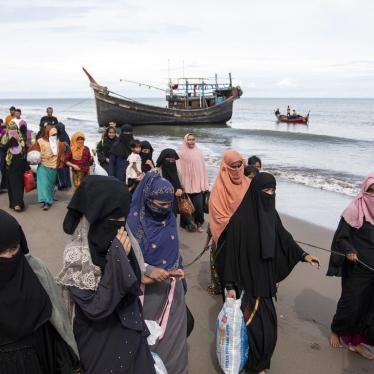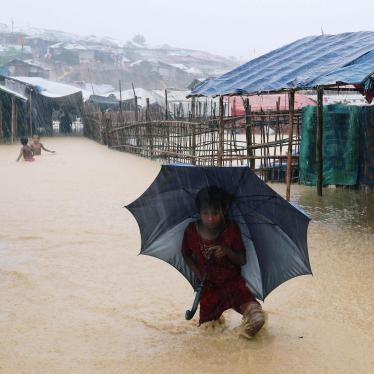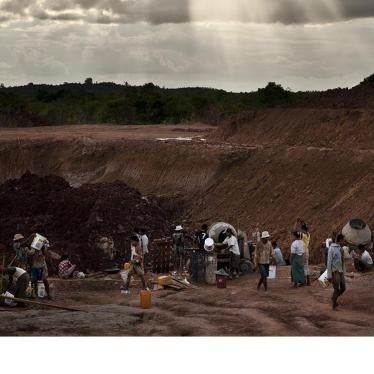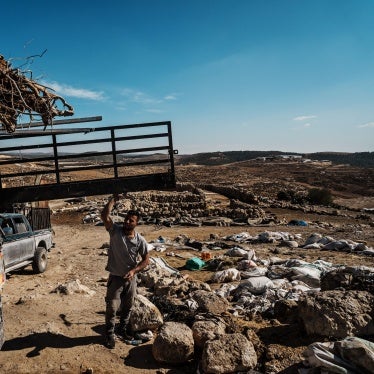(New York) – The Sri Lankan government should immediately lift its September order barring humanitarian agencies from the Vanni conflict area in northern Sri Lanka so they can assist thousands of persons displaced by flooding from Cyclone Nisha.
Experienced and impartial humanitarian agencies have offered to respond to the crisis, but face government obstruction. Only government-approved food convoys have been allowed to enter the Vanni since the government in September 2008 ordered the United Nations and nearly all humanitarian agencies to withdraw from the Vanni, severely limiting humanitarian access to the affected population. Cyclone Nisha hit northern Sri Lanka on November 25, 2008, causing heavy rains and flooding that reportedly forced between 60,000 and 70,000 people to relocate. Thousands of shelter kits and tarps are available from the humanitarian community to provide emergency shelters for the affected families, but the government has reportedly insisted that only tarps without logos from humanitarian agencies will be allowed into the Vanni. Such unnecessary restrictions on assistance are unacceptable in this time of urgent need.
“The Sri Lankan government should stop playing games with aid organizations and let them get on with their life-saving work,” said Brad Adams, Asia director at Human Rights Watch. “Tens of thousands of people in flooded areas of the Vanni are without adequate shelter and need help now.”
Government officials and humanitarian agencies estimate that between 230,000 and 300,000 displaced persons have been trapped in a small area of the eastern Vanni by fierce fighting between the Sri Lankan army and the separatist Liberation Tigers of Tamil Eelam (LTTE). The LTTE has refused to allow displaced persons in areas under its control to leave for government-held territory. It has increased forced recruitment of civilians, including children, as well as making civilians carry out regular forced labor in dangerous conflict areas. The LTTE has almost completely stopped giving out passes allowing civilians to leave the Vanni, with the exception of some urgent medical cases. Only about 1,000 persons have managed to flee the conflict zone since March 2008.
“The LTTE bears a heavy responsibility for the suffering of the civilian population in the Vanni,” said Adams. “By refusing to allow civilians their basic rights to freedom of movement, they have trapped hundreds of thousands of civilians in a dangerous war zone, in horrible conditions.”
The Sri Lankan authorities have not released any figures on the impact of Cyclone Nisha in the Vanni region. Local authorities have reportedly been instructed not to release any data to the public about the current humanitarian situation in the Vanni, but credible assessments indicate that between 60,000 and 70,000 persons in the Vanni have had to relocate because of the flooding. According to government figures, more than 20,000 persons have been displaced by flooding in neighboring Jaffna district, and the local authorities have called for emergency assistance, indicating the extent of the crisis in the region. The impact of the storm is likely to be far more severe in the Vanni because so many persons were displaced in the Vanni prior to the storm and were already living in flood-prone areas. Because of the flooding in the Vanni, a government aid convoy traveling on November 25 was forced to turn back, unable to deliver its supplies.
Human Rights Watch has previously reported that the Sri Lankan authorities have detained many displaced persons leaving the Vanni, holding them in closely guarded militarized camps near Mannar town. The government claims this is necessary for the safety of the detained civilians themselves, but the families detained in the camps have repeatedly stated their desire to leave; the government’s detention policy violates the rights of these displaced persons to freedom of movement.
On September 5, the Sri Lankan authorities ordered all UN agencies and humanitarian nongovernmental organizations to withdraw their staff and operations from the Vanni conflict zone, only allowing the International Committee of the Red Cross (ICRC) and the Catholic church-affiliated Caritas, which employs local staff only, to continue their operations. Since the forced humanitarian withdrawal in September, only six UN convoys with limited amounts of mostly food aid have entered the Vanni, as well as a smaller amount of government-supplied aid. India has donated more than 1,000 tons of humanitarian assistance to be distributed through the ICRC, but the restrictions on humanitarian operations have prevented the distribution of India’s aid to date.
Human Rights Watch rejected the government’s position that the forced withdrawal of aid agencies was necessary for the security of the humanitarian staff. The ICRC and Caritas continue humanitarian operations in the Vanni without significant security problems, and many of the most urgent humanitarian needs are found in areas away from the active fighting. The most serious security incident against humanitarian groups in Sri Lanka in recent years concerned the execution-style slaying of 17 local aid workers with the Paris-based Action Contre la Faim in August 2006; credible investigations found that Sri Lankan security forces were responsible, but to date no one has been arrested, let alone convicted, for the killings.
“If the humanitarian community can operate in conflict zones like eastern Congo, Somalia, and Iraq, they can operate in the Vanni as well,” said Adams. “The government’s argument that the safety of humanitarian workers in the Vanni cannot be guaranteed comes across as more of an excuse to conduct military operations without scrutiny than a statement of concern.”
Prior to the cyclone striking Sri Lanka, the humanitarian community repeatedly warned that living conditions for the displaced population trapped in the Vanni were deteriorating and urgently needed to be addressed. They found that the food supplied by the humanitarian convoys has been insufficient to meet the nutritional requirements of the population. There is also a desperate need for shelters, water and sanitation services (particularly toilets and safe water to prevent the spread of disease), medical assistance, and other basic needs. An October humanitarian assessment by a United Nations team concluded that at least 20,000 shelters were immediately needed at that time.
“The Sri Lankan government has prevented aid agencies from assisting thousands of desperate people in the Vanni,” said Adams. “Now is the time for the authorities to rethink these restrictions on humanitarian activities or be held responsible for the resulting deaths and suffering.”
